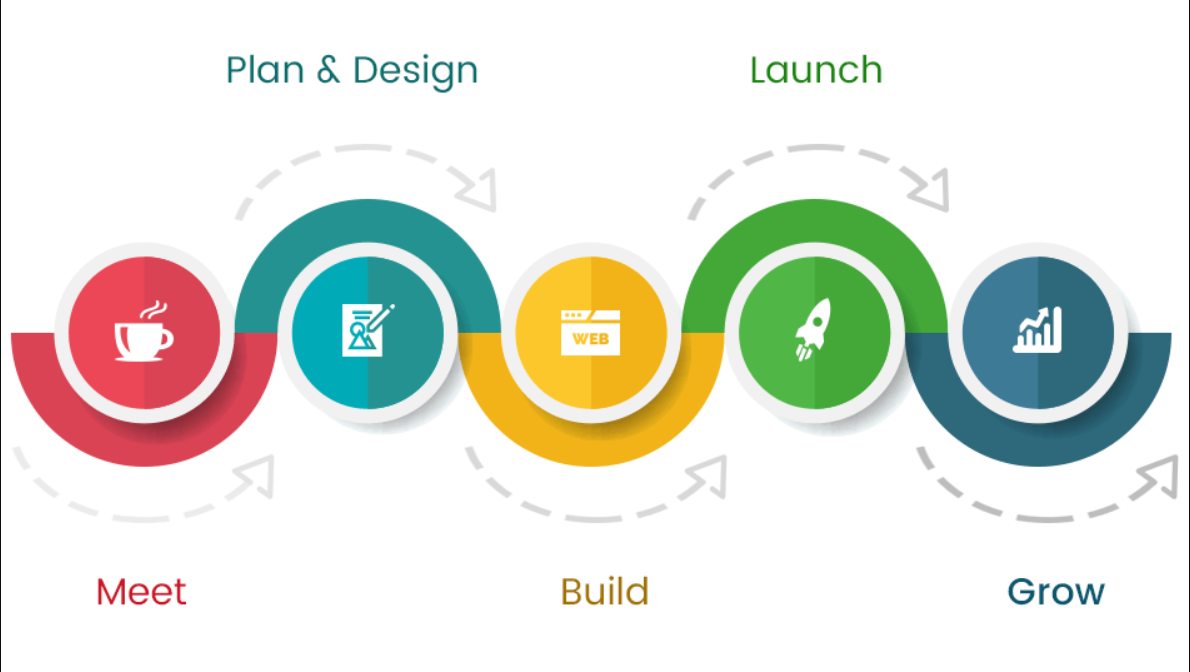Business digitalisation has become imperative to the success of the 21st-century enterprise, but the challenge that lies in front of organisations today is how to achieve this successfully and at pace.
Through the introduction of new technology and data science, businesses can learn from innovative concepts such as Business-to-Consumer (B2C) and Business-to-Business (B2B) models to get ahead of their competitors and futureproof their organisation against disruption by technological progress and market trends by digitising, innovating and transforming their business.
Business Digitalisation and innovation can help your business stand out from the crowd. I have prepared this guide to teach you what you must do.
What Is Business Digitalisation?
Digitalisation is the process of converting a physical object into a digital representation of it (i.e., data). Businesses are also undergoing a digitalisation process, aiming to improve decision-making by enabling companies to better understand customer behaviour and preferences through data analytics and visualisation tools.

Digitalising allows businesses to take advantage of new technologies that have emerged in recent years, such as artificial intelligence (AI) and augmented reality (AR), which can help them be more creative in their decision-making processes or develop new products or services not have been possible before. Digitalisation is fundamentally transforming traditional models of doing business by emphasising creativity, innovation and customer experience while encouraging entrepreneurialism among individuals within the company.
Businesses of all sizes can be affected by digitalisation, and implementing a more effective strategy that takes into account these developments can lead to positive changes in performance, making it an increasingly important factor in businesses’ long-term strategy. Big companies are increasingly investing in data analytics software and artificial intelligence (AI) tools as they seek ways to improve decision-making processes through improved customer understanding.
In recent years, several high-profile examples of businesses successfully utilising innovative technology to improve decision-making processes or develop new products or services that were not previously possible. Uber is an example of a company that has successfully implemented digitalisation strategies by using data analytics to track customer demand and providing real-time updates on driver availability while streamlining communication with customers through mobile phone apps.
Business Data Digitization; An Option for Growth
To make the process of digitising your data as straightforward as possible, there are many ways you can approach the task. One method is to hire a specialist or consultant that specialises in data analysis and digitization. You can also outsource this task to companies such as Teradata, who offer services like storage management, cloud-based data warehouses, business intelligence solutions and more. Another way to digitize your data is by investing in software that will handle the task for you automatically. For example, Apache Software Foundation offers a free, open-source Hadoop solution that allows you to store your data in HDFS (Hadoop Distributed File System) before analysing it with tools such as Pig or Hive.

You can also automatically digitize your data by employing what’s known as an ETL (Extract, Transform and Load) tool. To use one of these programs, you input your data into a database or spreadsheet in its raw form. The ETL tool will then search for patterns in your data that it recognises as relevant content, so for example if you were doing a project involving social media posts about certain topics, you could write some keywords into your ETL program along with hashtags or other information indicating what type of content it should be looking for. Once it finds these patterns of text in your raw data, it will reformat them, so they fit more efficiently into whatever database platform you’re using at the time.
If you want to digitise your data but don’t want to invest in expensive software or hire a consultant, there are other options for you. One of these options involves manually converting your data into numerical values before putting them into their corresponding database fields. This process can be done manually using spreadsheets or one of many cloud-based applications like Kaggle that provide automated tools for conversion. You’ll need some expertise or training in data analysis if you choose this method, so if you’re not comfortable with coding and programming, don’t attempt it without guidance from someone who knows what they’re doing.
Another option for digitising your data involves hiring a company specialising in natural language processing. These companies use algorithms, processes, statistical analysis and machine learning techniques to translate your raw data into content that can be analyzed by programs like Hadoop or IBM’s Watson. However, as with any business dealing that requires you to interact with third parties, you’ll need to research different companies before choosing one. You’ll want to ensure they’re reputable, licensed and have good customer service reviews from people who have used their services in the past. Look for those with specialities in specific industries so you get a higher level of expertise from them when it comes to your project.
What Do Businesses Gain from Digital Transformation and Innovation?
Digital transformation allows businesses to work smarter and more efficiently. It often means connecting different siloed areas of the business, such as marketing, sales, customer service, product development and manufacturing. By using digital tools like data analytics, artificial intelligence (AI) or automation, businesses can optimize processes for increased efficiency.

What does business digitalisation and digital transformation mean for your company or business, though? While digital can refer to anything electronic, when businesses use it in reference to a business process like marketing, sales or customer service, they generally mean smartphones—or any other mobile device.
To reap these benefits, businesses should invest in not only digital transformation but also innovation. That’s because transformation isn’t a one-time event; it has to be a continuous process of revamping your business for growth. It doesn’t stop when you launch your app or website; it continues throughout your business model lifecycle. Here are some innovative ways that successful companies are transforming:
Digital transformation helps a business grow by reaching new audiences and markets. Amazon revolutionised how retail stores do their day-to-day operations by offering convenience with same-day delivery. E-commerce platforms like Wish have opened up opportunities to small brands that would never have had the chance without going through traditional distribution channels. And now, social media networks like Instagram offer even more ways to connect with customers and drive revenue.
Amazon introduced many innovations which revolutionized the way people buy products, while social media platforms like Instagram allow companies to reach customers directly.
How do you stay competitive in this environment? Every business needs three key components to succeed:
- Innovation
- Strategy and
- Models.
These three factors help an organization become dynamic and remain at the top of its game. With them, organizations will eventually get stagnant and stay caught up in innovation. Make sure to continuously innovate, develop an effective strategy and align it with a clear business model that encompasses future needs! With those things in place, a business will stay ahead of the competition and move closer to being able to transform digitally. That’s because not just doing something digital but instead embracing an entire culture change towards digitization so that technology becomes embedded into everyday tasks. It may seem daunting, but remember many leaders who don’t make a transition risk getting left behind and losing competitiveness in the market.
Does it seem like a lot of work? It can be, but successful businesses are always on top of their game. To avoid falling behind, you need to adapt to meet current customer needs and trends constantly. This means continuously striving for innovation, making smarter decisions with data-backed strategy—and adapting business models that enable companies to stay competitive today and beyond. Doing so will transform your business into one that embraces digital technologies rather than working against them!
Learn more about how data can empower the digital transformation of your businesses and why it’s so important. Read our eBook, The Decision Maker’s Handbook to Data Science. Get it Now!
Processes You Need to Have in Place.
To successfully transform your business into a digital one, you’ll need to have processes that allow you to innovate digitally. This means having resources available for the entire organization, from leadership to the front line. For example, it may be useful to train your staff on how to use mobile devices efficiently or have an IT department that helps troubleshoot challenges quickly.

In addition, it’s essential to have an effective digital transformation strategy in place. This isn’t always easy, as it may mean changing your internal processes and priorities in favour of those that fit with a digital business model. For example, suppose you plan on having an e-commerce store online or producing online video content. In that case, you may need to reassign roles within your company so all staff can be involved in your digital transformation efforts. It also means putting aside resources that would otherwise be invested elsewhere in your business. Having a good strategy will help clarify what needs to be done first so you can successfully achieve results.
You’ll also need a model in place that supports your digital transformation goals. This might involve using digital assets or tapping into other new technologies, like data analysis tools, which allow you to take advantage of insights about your audience. Having a sound model will help ensure that your company can compete with any competition. The model should align with your business’s overall strategy and be an essential part of your operations. It can even include unique processes that help make sure innovations are added regularly. For example, develop a process where employees are encouraged to submit their ideas for improvements so you can tap into their creativity when developing new features or products.
It’s also important to have a business transformation strategy in place so you can quickly implement your strategies. A good plan will outline what needs to be done, when specific steps need to be taken, who will be involved in doing them and any requirements needed for completing each task. For example, you want to create a video marketing campaign as part of your digital transformation efforts. In that case, you may decide that it should take place during one of your quieter months so it doesn’t negatively impact sales from another area in your business. Having a well-developed strategy will allow you to keep everything organised so everyone can focus on their specific tasks with minimal confusion.
In order for your strategy to be successful, you’ll need a clear vision of what it will achieve. This means defining your goals in detail so you can clearly explain them to your staff. For example, if you want to increase online sales by 20%, then you may decide that such results should come from direct web traffic or Google searches rather than other sources like paid ads.
You may even go further and decide that Facebook and Twitter are two of your most effective digital channels for connecting with potential clients, so focus on increasing sales through those areas first. Your team will be motivated by having goals set in advance so they can make important decisions as soon as needed rather than waiting for instructions from leadership.
You’ll also need a budget in place so you can track how much money you’re spending on your digital transformation efforts. This will help ensure that funds are being used wisely, saving you money and giving you more funds for future projects.
Having different budgets in place is vital so you can separate costs associated with digital transformation from any other business expenses. For example, create a marketing budget specifically for your online sales channels rather than combining those marketing dollars into your general sales budget because it has its own unique costs involved.
It would help if you also had a digital transformation and innovation strategy in place. Consider making small changes rather than implementing one significant change immediately if you want to get started with digital transformation efforts. Consider adding some social media platforms to your marketing plan so customers can see what you offer without having to buy right away. Using targeted ads and other marketing tactics, you could build your social media presence over time as you develop a stronger customer base.
How Can Business Digitalisation Drive Growth in My Organisation?
The key points of business digitalisation and how it can drive growth in your business are:
• Increased customer reach
• Increased revenue
• Faster, more accurate decision-making
• Improved operational efficiencies.
• Greater customer satisfaction
Digital transformation helps businesses to grow their customer base by providing new opportunities for market expansion. It creates an environment that enables companies to increase their customer reach by taking advantage of technologies such as mobile apps, websites, virtual reality and augmented reality – all without incurring high costs or risk. With these technologies come many ways for companies to get closer to customers than ever before, including the ability to create targeted marketing campaigns that better appeal to individuals’ specific needs, preferences or habits while on the go. Thereby offering convenient self-service options such as online payments and chatbots, interacting with customers through social media channels like Facebook Messenger.
There are a number of ways that digital transformation can help businesses increase their revenue. In addition to reaching more customers through your mobile apps, websites, social media channels and other technology-driven platforms, companies are now able to offer 24/7 services such as online shopping or live chat, which creates more opportunities for consumers to buy your products at any time they choose.
Also, digital transformation allows companies to better serve their current customers by using data collected from these technological platforms—such as what users browse on your website or interact with in your mobile app. And gain insight into new opportunities for growth in their business.
1 Major Challenge of Business Digitalisation and Its Solution
A major challenge faced by organisations wanting to digitalize their business is that of decision-making. Digital transformation and innovation create growth opportunities, but it also creates challenges. We explore these challenges and how organisations can overcome them.
Digital strategy, or digitalisation strategy, refers to transforming an organisation’s business model into a technologically-enabled, data-driven system. It involves decisions on how we invest in technology and what changes we need to make in our processes, systems, and people.

An apparent digital transformation or innovation strategy will help businesses leverage their competitive advantage. At the same time, they take the risk of moving forward into the digital world – all while staying true to their core values, maintaining customer trust and goodwill, and meeting any regulatory requirements relevant to the industry.
Adopting digital transformation means that organisations must decide how their business will change concerning their digital assets, digital processes, talent, culture, operations, IT system capability and speed of decision-making. Some of these decisions will be difficult for leaders who must choose between doing things more quickly or in more complex ways using new technologies.
How Business Decision-Makers Can Overcome Challenges
When setting out on a digital transformation journey, the most important thing an organisation can do is set up a digital leadership team consisting of key business decision-makers responsible for ensuring digital decisions are always considered part of the overall strategy. This digital leadership team should meet regularly and have the following three responsibilities:
A) Make sure that digital transformation is embedded in everything the organisation does;
B) Ensure transparency through updates to stakeholders on progress; and,
C) Develop an implementation plan with clear milestones. Key points about digital transformation and innovation :
To maximise your success, you’ll need to start making decisions today about where your organisation will go tomorrow. Be aware that this may lead to some challenging discussions among senior management teams about short-term versus long-term investments. You’ll also want to think about whether you’re ready for this kind of digital transition – whether the company culture is ready for the shift from analog to digital. You’ll want to work on developing a digital roadmap which outlines your objectives and has measurable goals, so everyone knows what success looks like.

Digital transformation requires executives and stakeholders across all levels of an organisation (including management, employees, and partners) to be engaged to achieve its full potential. Digital transformation and innovation strategies include aspects such as people, digital assets, digital processes, talent, culture, operation systems and IT systems. There are challenges faced by organisations wanting to digitalise their business, including challenges of decision-making.
To maximise the successful implementation of digital transformation strategies in organisations, key decision makers across different levels of an organisation with input from managers, employees and partners.
The vision for digital transformation is that business executives and all stakeholders are engaged in designing a culture of continuous innovation, growth, customer loyalty, competitive advantage and ultimately overall corporate success.
What Is the Future of Digital Transformation?
Businesses need to be digitally savvy in order to stay competitive. No matter what the industry, digital transformation is required for business growth. The future of digital transformation will require us to think about how artificial intelligence can help us do our jobs more efficiently, how machine learning can enable self-learning businesses and how data science will make our lives easier.

Ultimately, digital transformation isn’t just about how you conduct your business today; it’s also about preparing for tomorrow. The future of business will be data-driven, agile and highly automated. While business as usual won’t disappear entirely, we can expect businesses to be far more flexible in their operations going forward.
The future of digital transformation will be multi-faceted. One thing’s certain: businesses that can master its many elements are sure to stand out as leaders in their fields. The future of digital transformation requires organisations to become more adaptable, open and responsive – allowing them to react quickly and efficiently. Traditional hierarchical structures with siloed teams will not work in the future of digital transformation.
Successful organisations will be those who can navigate constantly shifting complexities through collaboration across all levels of an organisation, drawing on each individual’s strengths. They must rethink their operating models and strategies to focus on customer experience instead of efficiency or productivity as a means to achieve growth. Organisations should find new ways to collaborate internally, design new customer experiences and reinvent themselves by breaking down barriers between departments so they can innovate together like never before!
How Tesseract Academy Can Help Your Business Grow
Tesseract Academy provides a range of solutions to help businesses grow. Whether you’re a business leader or entrepreneur, we can help your business succeed.
Our dedicated team of experts will provide you with a tailored solution that fits your business. We want to help you innovate, stay on top of your game, take advantage of new trends and boost your performance. Using our bespoke services allows you to concentrate on what’s important – growing your business.

• Competitor Analysis: We gather information about how others in your industry are using data and technology for competitive advantages so that you can do the same. Understanding your competitors’ strategies to advance their business will make it easier for you to strategise against them.
• Big Data Analytics: Gathering and analysing large quantities of data helps us understand customers better and provide the most effective recommendations. Our expertise enables us to analyse vast amounts of structured or unstructured data from different sources, identify patterns and extract insights.
• Cloud Solutions: We can create customised cloud solutions based on your needs and budget constraints. Building an infrastructure solely for your company might not be feasible, but this does not mean that you have to go without the latest advances in technology.
• Data Integration: Our business intelligence solutions help you make sense of data from multiple disparate systems by integrating it into one place. We can speed up decision-making processes by giving employees access to all information relevant to their jobs in a single place.
Contact us today!
Business digitalisation, transformation and innovation are not just buzzwords. Digitalisation has the potential to change how businesses work, how they interact with customers and how they make money. This guide will introduce you to the meaning of digital transformation and innovation for businesses.
When you reach out today, we’ll analyse your needs, goals, and priorities so we can recommend solutions that will help you create value.
Contact us today for more information about how business digitalisation, digital transformation and innovation can drive growth in your business. Our experts will help you to identify opportunities and create a roadmap to success.

























